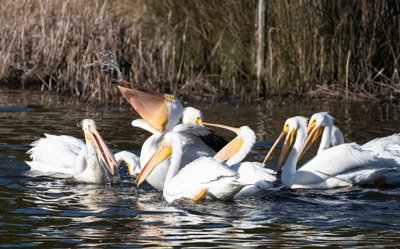
When we think of pelicans along South Carolina’s coastline, the iconic Brown Pelican often comes to mind, gracefully diving headfirst into the ocean to catch fish. But over the last few years, an equally remarkable cousin—the American White Pelican—has been making its presence known more frequently in the skies and on the shores around Seabrook Island. These traditionally rare visitors are becoming more frequent in our marshes, freshwater lakes,
and birding hotspots. Here’s a closer look at these majestic birds and their growing presence in South Carolina.
Size and Appearance
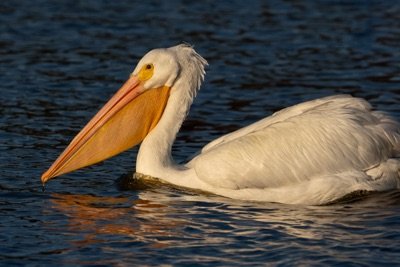
Photo by Sandy Stolzman
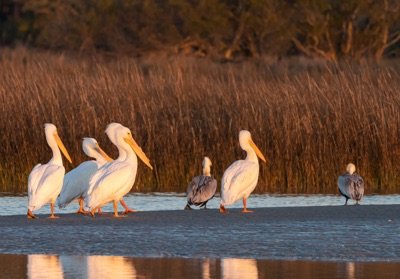
Photo by Glen Cox
The American White Pelican is one of the largest birds in North America, second only to the California Condor, boasting an impressive wingspan of up to 9 feet and weighing between 10-20 pounds. Often it may be difficult to appreciate their size without context, but if you see a White Pelican standing next to a Brown Pelican you will realize that they are nearly twice as large! Their snowy white feathers and black-tipped wings are unmistakable when they take
flight. They also have a striking long orange bill with an expandable pouch for catching fish. During breeding season, both males and females develop a distinctive “breeding bump” on their beaks, and their bills, legs, and feet turn a vibrant reddish-orange.
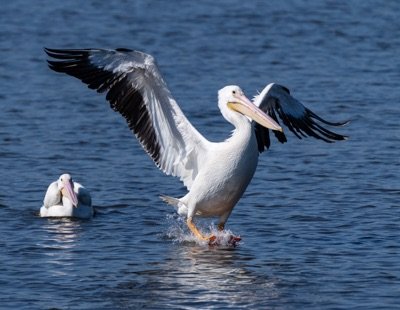
Photo by Glen Cox

Photo by Sandy Stolzman
To distinguish them in flight, note that their black wing tips cover only the outer two-thirds of each wing’s trailing edge, unlike the full trailing-edge black pattern seen on Wood Storks or “tips only” black feathers on a White Ibis. Juvenile White Pelicans are similar in size and shape to adults but sport a dusky hue on their head, neck, and back.
Habitat and Migration
White Pelicans breed in the northern Midwest of the United States and Canada, favoring freshwater lakes and marshes. They migrate south for winter, traveling in spectacular V-formations of 100–200 birds at altitudes exceeding 5,000 feet. Their wintering grounds traditionally include the Gulf Coast and inland regions of the southern U.S. and Mexico.

Drone Photo by Jeffrey J Davis
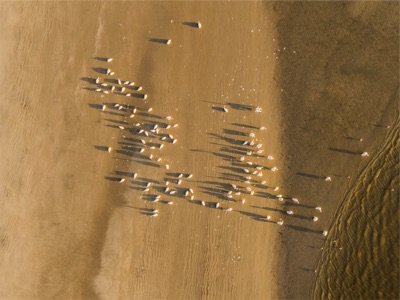
Drone Photo by Jeffrey J Davis
While South Carolina’s Lowcountry is slightly out of their traditional range, sightings have increased in recent years. These graceful birds have been spotted integrating into Brown Pelican colonies on Deveaux Bank and other bird islands along the Southeast coast. They also frequent South Carolina freshwater lakes such as Murray, Greenwood, and Wateree. Around Captain Sams Inlet, they often gather in mixed flocks with Black Skimmers, egrets, Royal
Terns, Brown Pelicans, and Double-crested Cormorants.
Behavior and Diet
Unlike their Brown Pelican cousins, who dive spectacularly into the water for their meals, American White Pelicans are cooperative hunters. They scoop fish into their large bills while swimming, often working together in groups to corral their prey. Their diet primarily consists of fish, although they
may also consume crustaceans and amphibians when available
White Pelicans are fascinating social creatures. Chicks, while still inside the egg, can communicate discomfort by squawking if the temperature becomes too hot or cold. Once hatched, they leave the nest at 2-3 weeks old to form “crèches,” or group nurseries, while parents forage for food.
Adults are generally silent, but they respond to threats with unique behaviors. On land, they may grunt and adopt an upright posture, while in the air, they soar high on stable, broad wings. They defend themselves from predators—including foxes, coyotes, gulls, and even bald eagles—by lunging forward with their massive bills.
Conservation and Future in South Carolina
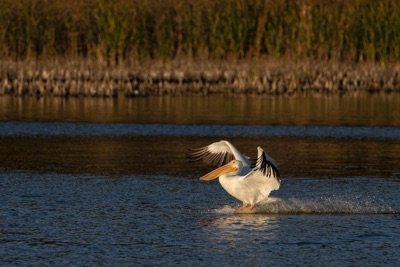
The American White Pelican is protected under the Migratory Bird Treaty Act, and their populations are stable or growing across much of their range. John Audubon documented their presence in South Carolina more than 200 years ago, noting their rarity even then. Today, their return to our shores and inland lakes is a hopeful sign for bird enthusiasts and conservationists alike.
If you’re lucky enough to spot these majestic birds this winter, take a moment to appreciate their quiet elegance. Whether they’re gliding effortlessly through the sky or gathering in huddled flocks along our salt marshes, the American White Pelican is a sight to behold—a graceful reminder of the rich biodiversity that calls South Carolina home
Source: The Cornell Lab All About Birds
Submitted by Jeff Davis
